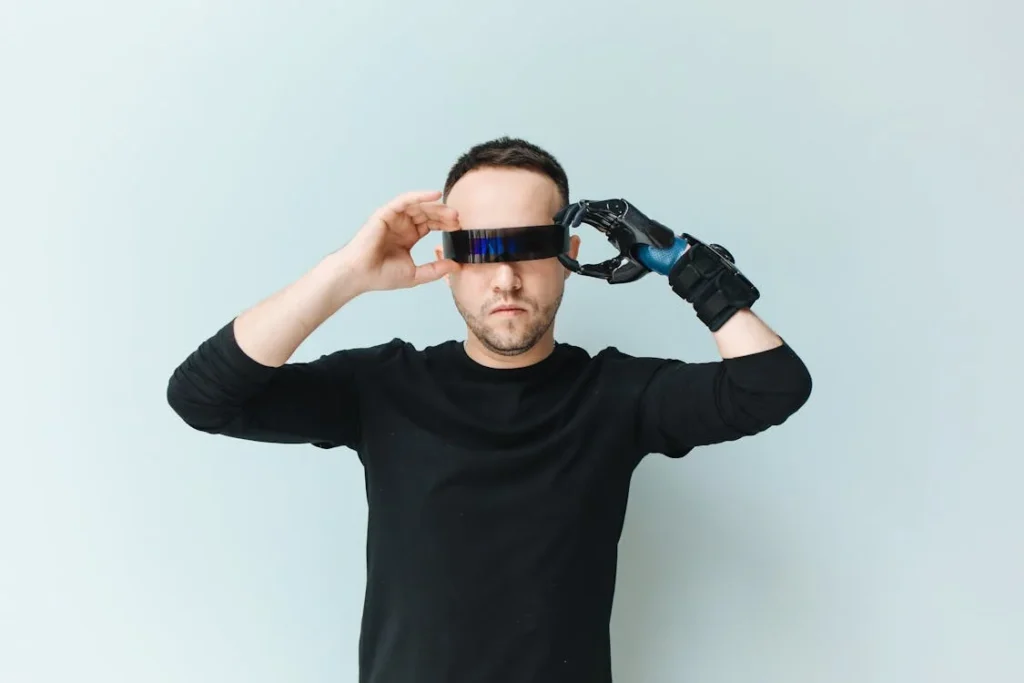For people with upper limb loss, choosing the right prosthetic is a life-changing decision. Some prosthetics use myoelectric technology, which responds to muscle signals, while others rely on body-powered mechanisms, controlled by shoulder or arm movement. Each system has its own strengths, but what if you could combine the best of both?
Hybrid upper limb prosthetics do exactly that. By merging myoelectric and body-powered functions, they provide greater control, flexibility, and reliability. These advanced prosthetics allow users to switch between different modes, making daily tasks easier and more intuitive. Whether it’s lifting a heavy object or performing delicate movements, a hybrid prosthetic adapts to the user’s needs.
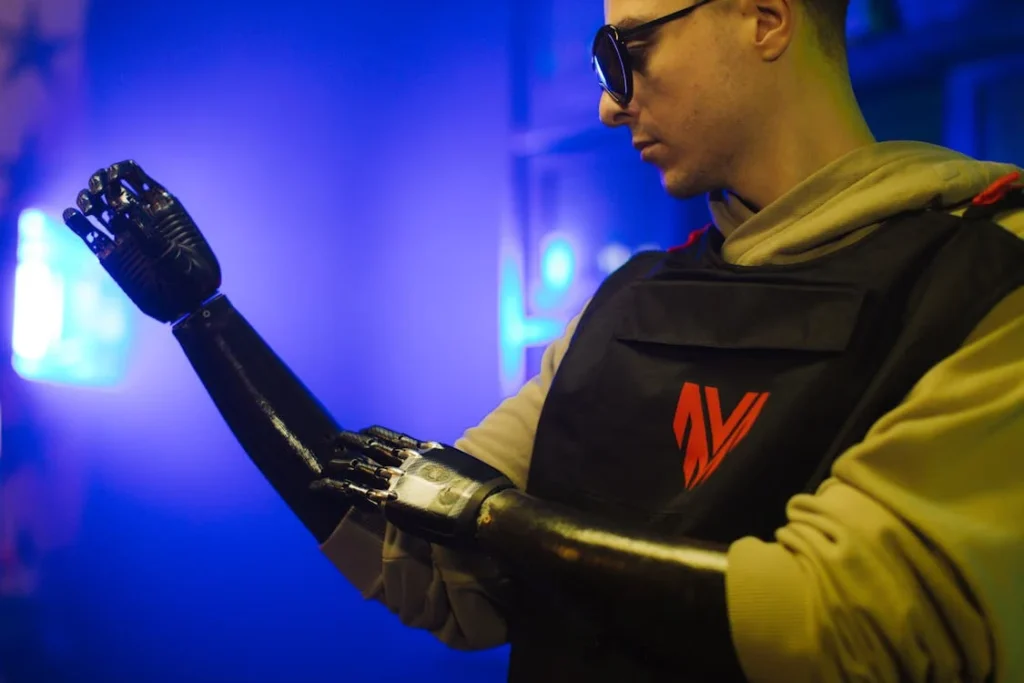
How Hybrid Upper Limb Prosthetics Work
Hybrid prosthetic systems combine the strengths of both myoelectric and body-powered technology to offer a more versatile and responsive experience.
Instead of relying entirely on one method of control, they integrate both systems, allowing the user to choose the most efficient way to move their prosthetic hand based on the task at hand.
This flexibility makes them ideal for individuals who need both precision and strength in their daily activities.
The Role of Myoelectric Control
Myoelectric prosthetics function by detecting electrical signals from the user’s residual muscles. When a person thinks about moving their missing hand, the muscles in their residual limb still contract.
These small electrical signals are picked up by electrodes placed inside the prosthetic socket, which then send commands to the motors in the artificial hand.
This allows for smooth and natural movements without the need for excessive force or external harnesses.
One of the key benefits of myoelectric control is the ability to perform fine motor tasks. Actions like picking up small objects, holding a pen, or using a touchscreen require subtle finger movements that a myoelectric system can handle with ease.
By integrating artificial intelligence and machine learning, modern myoelectric prosthetics can even adapt to a user’s unique muscle signals over time, making control feel more intuitive.
The Strength of Body-Powered Systems
While myoelectric technology offers precision, body-powered prosthetics excel in strength and durability. These prosthetics use a harness and cable system, where movements of the shoulder, back, or elbow generate the force needed to open or close the artificial hand.
Because body-powered systems do not rely on batteries or electrical components, they are highly reliable and function well in rugged conditions.
The mechanical design of body-powered systems also allows users to exert more force when gripping objects.
For physically demanding tasks such as carrying groceries, holding onto railings, or using tools, body-powered control provides a stronger and more immediate response than myoelectric options.
Since the movement is generated directly by the user’s body, the response time is nearly instantaneous.
The Integration of Both Systems in a Hybrid Prosthetic
A hybrid prosthetic allows users to switch between myoelectric and body-powered control, giving them the best of both worlds.
Some models use myoelectric signals for fine motor tasks while activating a body-powered system for gripping and lifting heavier objects.
This means a user can perform delicate actions with precision while still having the strength to handle physically demanding activities.
Hybrid systems also improve energy efficiency. Myoelectric prosthetics rely on batteries, which can drain quickly with heavy use.
By incorporating body-powered elements, hybrid prosthetics reduce power consumption, ensuring that the prosthetic remains functional for longer periods without needing to recharge.
Another major advantage is the added reliability. If a battery runs out or an electronic component malfunctions, the user can still rely on the body-powered system to control their prosthetic.
This provides a level of security, especially in environments where recharging a myoelectric device is not always convenient.
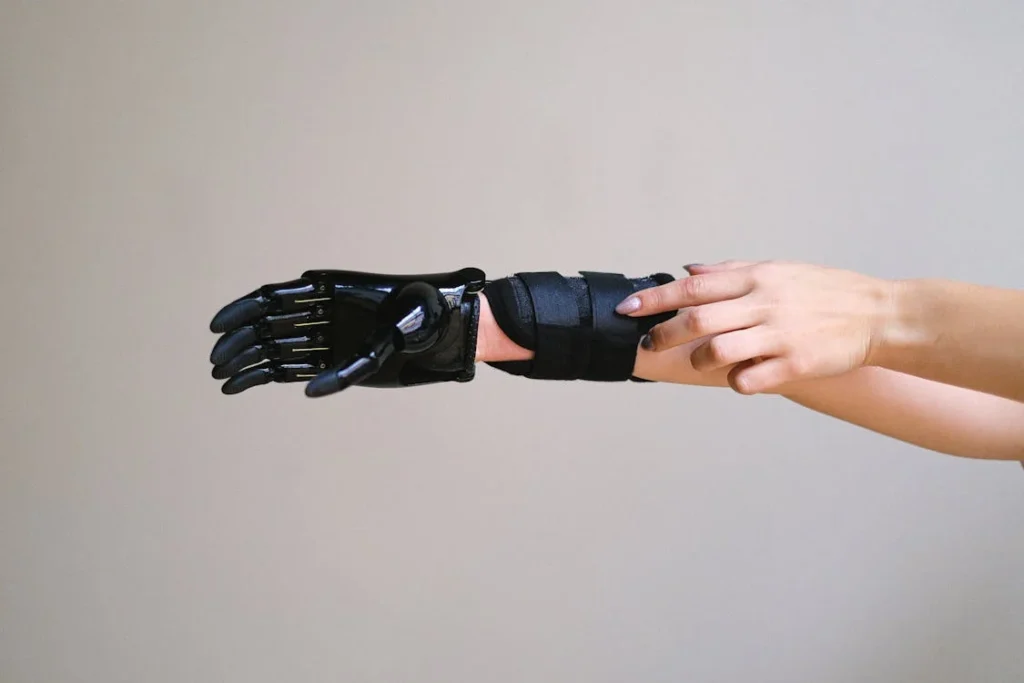
The Benefits of Hybrid Upper Limb Prosthetics
Hybrid prosthetics are designed to provide users with more control, adaptability, and comfort than single-mode prosthetics.
By integrating both myoelectric and body-powered systems, these devices offer a seamless experience that enhances everyday functionality.
The combination of these two control methods makes hybrid prosthetics a preferred choice for individuals looking for both strength and precision in their artificial hand.
Greater Versatility in Everyday Tasks
One of the biggest advantages of hybrid prosthetics is their ability to adapt to different situations. Users can switch between myoelectric and body-powered control depending on the task.
If a person needs to perform delicate activities, such as typing on a keyboard or buttoning a shirt, the myoelectric system allows for precise, small movements.
For tasks requiring more force, such as lifting objects or gripping something firmly, the body-powered system provides the necessary strength without draining battery power.
This adaptability is particularly useful in professional settings where users may need to perform a wide range of actions throughout the day.
A person working in an office might use the myoelectric function for tasks like writing, while relying on the body-powered system for physically demanding activities like carrying heavy files or operating machinery.
The ability to alternate between these two modes ensures that the prosthetic does not limit the user’s work or lifestyle.
Reduced Fatigue and Increased Efficiency
Using a prosthetic all day can be tiring, especially if it relies on a single control system. Myoelectric prosthetics, while advanced, require constant muscle contractions to generate signals, which can lead to muscle fatigue over time.
Similarly, body-powered prosthetics demand physical effort from the shoulder or back, which can become exhausting if used for extended periods. Hybrid systems help reduce strain by allowing users to balance their energy expenditure.
When one system becomes tiring, they can switch to the other, ensuring longer and more comfortable use throughout the day. This balance not only enhances endurance but also minimizes discomfort, making hybrid prosthetics a practical choice for individuals who require prolonged use.
Enhanced Reliability and Backup Functionality
One of the major concerns with fully electronic prosthetics is their dependence on battery life. If the battery runs out, the device becomes non-functional until recharged. A hybrid prosthetic eliminates this issue by providing a body-powered backup.
Even if the myoelectric system fails or the battery depletes, the user can continue using their prosthetic with the body-powered control. This feature is particularly beneficial for people who work in environments where recharging may not always be possible, such as construction sites, outdoor jobs, or rural areas.
The assurance that the prosthetic will continue to function under any circumstance gives users peace of mind, making them less dependent on technology failures.
Improved Durability and Cost-Effectiveness
Myoelectric prosthetics rely on motors, sensors, and electronic components, which can be vulnerable to wear and tear. Body-powered systems, on the other hand, use mechanical cables and harnesses that are rugged and long-lasting.
By combining both technologies, hybrid prosthetics reduce the overall strain on delicate electronic components, increasing the lifespan of the device.
Hybrid prosthetics also reduce long-term maintenance costs. Since the body-powered system does not rely on complex electronics, repairs are often simpler and more affordable.
This makes them a cost-effective solution for individuals looking for a prosthetic that balances advanced technology with practical durability.

Who Can Benefit the Most from Hybrid Upper Limb Prosthetics?
Hybrid prosthetic systems offer a unique blend of control and flexibility, making them suitable for a wide range of users.
While both myoelectric and body-powered prosthetics serve specific needs, a hybrid approach ensures that individuals do not have to compromise on either precision or strength.
Understanding who benefits the most from this technology can help in making an informed decision when selecting a prosthetic.
Users with High Activity Levels
Individuals with physically demanding lifestyles benefit greatly from hybrid prosthetics. Those who work in labor-intensive jobs, such as mechanics, construction workers, or factory employees, often require strong grip force and durability.
A fully myoelectric prosthetic may struggle with high-impact activities due to battery limitations, while a body-powered prosthetic alone may not provide the fine motor control needed for intricate tasks.
By combining both technologies, users can adapt to different work environments without limitations.
Athletes and fitness enthusiasts also find hybrid prosthetics useful. Whether engaging in weightlifting, cycling, or rock climbing, they need a prosthetic that can withstand high force movements while maintaining flexibility.
A hybrid system allows them to switch to body-powered control for strength-based activities while using the myoelectric system for detailed, controlled motions.
Individuals Who Perform a Wide Range of Daily Tasks
Many people with limb loss require a prosthetic that can handle both light and heavy-duty activities throughout the day. Simple household tasks like cooking, cleaning, and personal grooming require dexterity and grip variation, while activities like lifting shopping bags, opening doors, or driving demand powerful gripping ability.
A hybrid prosthetic enables users to transition effortlessly between tasks without excessive strain. Parents, caregivers, and professionals often need their hands to perform different types of movements depending on their responsibilities.
A teacher, for example, might use myoelectric control for writing on a whiteboard but rely on body-powered control when carrying books or setting up classroom materials. The adaptability of a hybrid prosthetic makes it an excellent choice for users who need versatility in everyday life.
Users Seeking a Long-Lasting and Reliable Solution
Reliability is a major factor when choosing a prosthetic. Some users, particularly those who live in remote or rural areas, may not always have access to frequent charging or maintenance services. A hybrid prosthetic ensures continued functionality, as the body-powered system provides a dependable backup when the battery runs low.
This is especially important for individuals who travel frequently or work in conditions where recharging is inconvenient. Additionally, users who require a long-term prosthetic solution often prefer hybrid models due to their durability and reduced maintenance costs.
Since the body-powered component absorbs much of the physical strain, the electronic parts of the prosthetic experience less wear and tear. This reduces the frequency of repairs and extends the overall lifespan of the device.
People Transitioning from a Body-Powered to a Myoelectric Prosthetic
For individuals who have been using body-powered prosthetics for years, switching to a fully myoelectric device can be challenging. The learning curve for a myoelectric system requires muscle reconditioning and mental adaptation, which can take time.
A hybrid prosthetic serves as a stepping stone by allowing users to retain their familiar body-powered control while gradually getting used to the myoelectric system.
This smooth transition is particularly helpful for older users or those who prefer a progressive adjustment to advanced prosthetic technology.
Instead of making an abrupt switch, they can slowly build confidence in myoelectric functionality while still relying on the body-powered mechanism when needed.
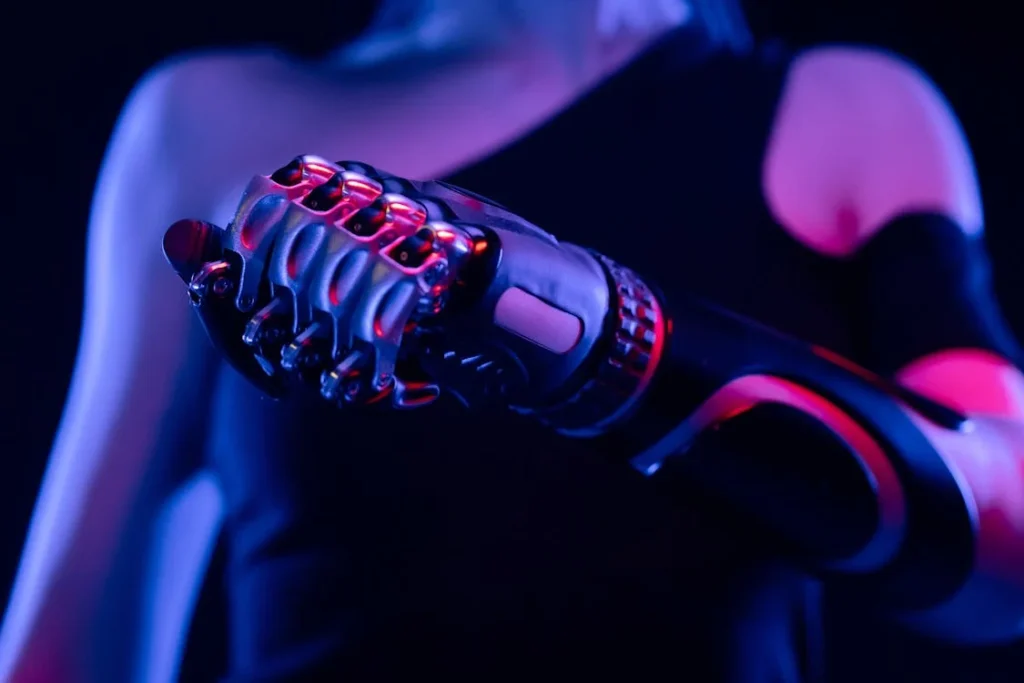
The Future of Hybrid Upper Limb Prosthetics
Hybrid prosthetics are already changing lives, but ongoing advancements in technology promise even greater improvements. The combination of myoelectric and body-powered systems is just the beginning.
As researchers develop smarter, more intuitive prosthetic designs, users can expect increased functionality, enhanced comfort, and a more seamless integration between artificial limbs and the human body.
Advancements in Artificial Intelligence and Adaptive Learning
One of the most exciting areas of innovation in prosthetic technology is artificial intelligence. Current myoelectric systems require users to train their muscles to produce consistent signals for movement control.
However, future hybrid prosthetics will incorporate AI-powered learning, allowing the prosthetic to recognize a user’s movement patterns and automatically adjust to their unique muscle signals. This will make the transition between body-powered and myoelectric control even smoother, requiring less effort from the user.
Machine learning algorithms will also enhance grip functionality. Instead of manually switching between different grip patterns, future hybrid prosthetics could predict the type of grip needed based on past movements.
For example, if a user frequently picks up a coffee cup in the morning, the prosthetic could automatically prepare the correct grip without requiring extra effort.
Integration of Haptic Feedback for a Sense of Touch
A major limitation of current prosthetic systems is the lack of sensory feedback. While myoelectric and body-powered hands allow for movement, they do not provide a sense of touch. This makes it difficult for users to gauge how much pressure they are applying when holding objects, sometimes leading to accidental drops or an overly tight grip.
Scientists are developing haptic feedback systems that use sensors in the prosthetic fingers to send signals back to the nervous system. This means users will eventually be able to feel textures, pressure, and even temperature variations.
By combining haptic feedback with hybrid control, prosthetics will not only move like a natural hand but also provide a more intuitive sensory experience.
Lighter and More Comfortable Materials
Prosthetic comfort is crucial for long-term use. Hybrid prosthetics, while already designed for versatility, will continue to evolve with lighter, stronger, and more flexible materials.
Carbon fiber, lightweight alloys, and even 3D-printed components are being developed to reduce the weight of prosthetic arms without sacrificing durability. Socket design is also improving to ensure a more customized and breathable fit, reducing pressure points and discomfort.
As materials become more advanced, hybrid prosthetics will become even more wearable, allowing users to go about their day with greater ease.
Wireless Connectivity and Smart Prosthetics
With the rise of wireless technology, future hybrid prosthetics will likely feature Bluetooth and cloud connectivity. This would allow users to fine-tune their prosthetic settings through a smartphone app, track usage patterns, and even receive software updates for improved performance.
Smart prosthetics could also integrate with other assistive technologies, such as voice commands or gesture-based control, making them even more intuitive to use.
Some research is also focused on brain-controlled prosthetics, where neural interfaces allow for direct communication between the prosthetic and the brain.
While still in experimental stages, this technology could one day eliminate the need for muscle signals altogether, offering completely seamless movement control.
Expanding Accessibility and Affordability
One of the biggest challenges in prosthetic technology is affordability. Many advanced prosthetics remain out of reach for individuals in developing countries or those without access to specialized healthcare.
Companies like Robobionics are working to change this by developing affordable, high-quality hybrid prosthetics that provide advanced functionality without excessive costs.
With innovations in 3D printing, modular designs, and locally manufactured components, hybrid prosthetics will become more accessible to people in all regions.
The goal is to ensure that individuals with limb loss, regardless of their economic background, have the opportunity to benefit from cutting-edge prosthetic solutions.

Choosing the Right Hybrid Upper Limb Prosthetic
Selecting a prosthetic is a highly personal decision that depends on lifestyle, daily activities, and personal preferences. Hybrid prosthetics offer a balance of strength and precision, but the right model should match the user’s needs for both comfort and functionality.
Understanding key factors such as fit, control mechanisms, and rehabilitation support is crucial when choosing the best prosthetic solution.
Understanding Individual Needs and Activity Levels
A person’s daily routine plays a significant role in determining the right prosthetic system. Someone who works in an office may require a prosthetic that allows for fine motor control, making myoelectric functions more essential.
In contrast, individuals with physically demanding jobs or active lifestyles may prioritize the durability and gripping power of the body-powered component.
Hybrid prosthetics provide the flexibility to switch between these functions, but the level of reliance on each system will vary based on personal activities.
Comfort is also a crucial factor. A prosthetic that is too heavy or does not fit well can cause strain on the residual limb, leading to discomfort and even long-term issues such as skin irritation or muscle fatigue.
Newer hybrid models offer lighter materials and custom-fit socket designs, making them easier to wear for extended periods. Before committing to a specific prosthetic, users should ensure that it provides both a secure fit and ergonomic support for their unique needs.
The Importance of Prosthetic Training and Rehabilitation
Adapting to a hybrid prosthetic requires training, especially for individuals who have never used a myoelectric system before.
Since hybrid models integrate two different control methods, users need to practice switching between them for optimal efficiency.
Rehabilitation programs are designed to help users build confidence in their prosthetic while improving coordination and muscle control.
Gamified rehabilitation is emerging as a key tool in prosthetic training. Interactive exercises, often paired with virtual reality or video games, help users develop precise control over their artificial hand in an engaging and motivating way.
By making the learning process enjoyable, these training methods reduce frustration and shorten the adjustment period for new users.
Customization and Adjustability
Not all hybrid prosthetics are designed the same way, and customization is often necessary to ensure the best experience. Some users may prefer greater reliance on myoelectric control, while others may need a stronger body-powered mechanism.
Many modern hybrid prosthetics allow for adjustable grip strengths, sensitivity settings, and control modes, enabling users to tailor the device to their preferences. Customization extends beyond function—it also applies to the aesthetic design of the prosthetic.
Advances in 3D printing and personalized coverings allow users to choose designs that match their personality, from natural-looking limbs to sleek, futuristic styles.
Feeling comfortable with the appearance of a prosthetic can significantly improve confidence and self-image.
Long-Term Maintenance and Support
A prosthetic is a long-term investment, so maintenance and serviceability should be a priority when choosing a hybrid model.
While body-powered systems are typically low-maintenance, myoelectric components require occasional servicing to ensure the electrodes, motors, and batteries continue functioning properly.
It is important to consider availability of repair services and replacement parts, especially for individuals living in areas where advanced prosthetic support may be limited.
Robobionics offers local servicing and quick repair options, ensuring that users can continue using their prosthetic without long downtimes.
Access to aftercare services, professional guidance, and technical support ensures that the prosthetic remains functional and efficient for years to come.
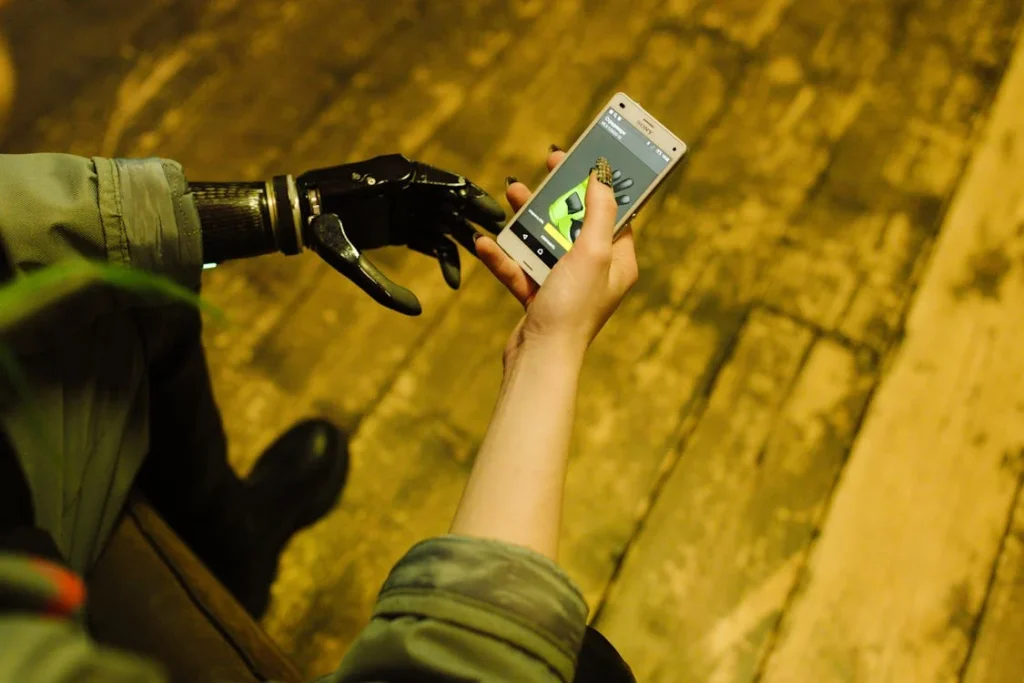
How Hybrid Prosthetics Improve Quality of Life
A well-designed prosthetic does more than restore movement—it enhances overall quality of life by providing independence, confidence, and the ability to engage in daily activities without limitations.
Hybrid prosthetics offer a unique advantage by allowing users to perform a wide range of actions with greater ease, ensuring they can live a fulfilling and active life.
Regaining Independence in Everyday Activities
For individuals with upper limb loss, simple tasks that were once effortless can become challenging. Cooking, dressing, using a smartphone, or even shaking hands may feel difficult without proper control.
Hybrid prosthetics make these activities more intuitive by allowing users to alternate between myoelectric precision and body-powered strength, depending on the situation. Being able to complete tasks independently restores a sense of control over one’s life.
Many users report feeling more self-reliant when they no longer have to depend on others for basic activities. The ability to grip utensils while eating, type on a keyboard, or carry grocery bags without assistance helps users feel capable and empowered in their daily routines.
Boosting Confidence in Social and Professional Settings
The way a person feels about their prosthetic plays a huge role in their confidence and mental well-being.
Hybrid prosthetics are designed not only for function but also for aesthetic appeal and natural movement, helping users feel more at ease in social settings.
When a prosthetic hand moves fluidly and responds naturally to muscle signals, it reduces the feeling of artificiality, making interactions more comfortable. In professional environments, a reliable prosthetic can make a significant difference.
Jobs that require fine motor skills, such as writing, operating machinery, or handling small tools, become much easier with the adaptive control of a hybrid system. This ensures that users can pursue their careers with confidence, knowing their prosthetic can keep up with workplace demands.
Returning to Hobbies and Physical Activities
Many people worry that losing a limb means giving up the activities they once loved. Hybrid prosthetics, however, allow users to reconnect with hobbies and interests that may have seemed impossible after amputation.
Whether it’s playing a musical instrument, painting, cycling, or even participating in sports, hybrid prosthetics offer the adaptability needed to engage in these activities again. For those who enjoy outdoor adventures or physical fitness, hybrid models provide the durability needed for intensive movement and impact-based tasks.
Hiking, rowing, and weight training are possible with reinforced grip control and adjustable movement patterns, ensuring users can stay active without compromising on stability or safety.
Reducing Stress and Mental Fatigue
One of the often-overlooked benefits of hybrid prosthetics is the reduction of mental fatigue. Single-mode prosthetics, whether fully myoelectric or body-powered, require constant effort and adaptation.
Users must focus on either generating precise muscle signals or manually controlling movement through body motion, which can be exhausting over time. Hybrid systems ease this burden by allowing users to switch between control modes, depending on what feels most natural at any given moment.
This reduces the amount of mental and physical strain needed to operate the prosthetic, leading to a more relaxed and effortless experience throughout the day.
Creating a Positive Outlook on Prosthetic Use
The emotional and psychological journey of adjusting to a prosthetic is just as important as the physical one. Many individuals experience a period of uncertainty or frustration when learning to use a new limb.
However, hybrid prosthetics simplify the adaptation process by providing a smoother learning curve and a more responsive design. By making movements feel more natural and intuitive, users are more likely to embrace their prosthetic as part of themselves, rather than seeing it as a mechanical replacement.
This shift in mindset fosters a positive relationship with the prosthetic, encouraging long-term use and improved self-image.
Conclusion
Hybrid upper limb prosthetics offer the perfect balance of precision and power, combining myoelectric control for fine motor skills with body-powered strength for durability and reliability. This unique integration provides users with greater independence, comfort, and adaptability in everyday life. Whether performing delicate tasks, engaging in physical activities, or working in demanding environments, a hybrid prosthetic ensures that users can move naturally and confidently.
Beyond functionality, these prosthetics enhance overall well-being by reducing fatigue, improving social confidence, and making adaptation easier. The ability to switch between control modes gives users the freedom to engage in daily tasks without limitations, restoring a sense of normalcy and empowerment.
At Robobionics, we are committed to providing high-quality, innovative prosthetic solutions that improve lives. If you or a loved one is considering a hybrid upper limb prosthetic, book a free consultation today and take the first step toward a more independent future.



